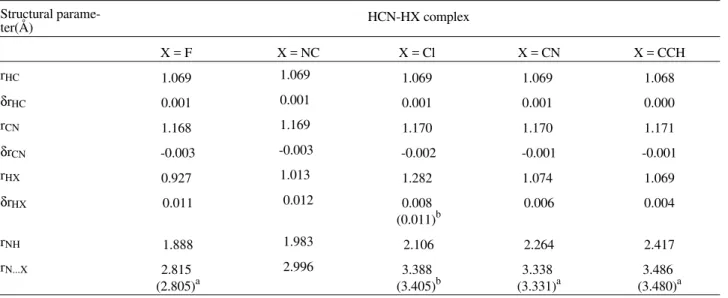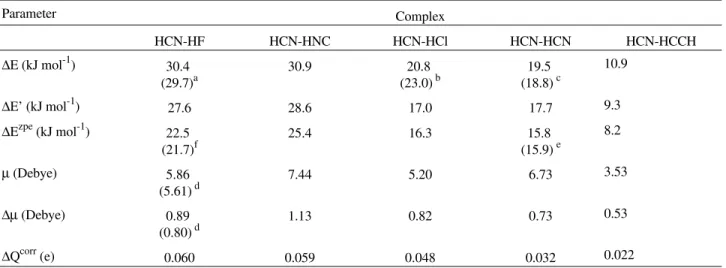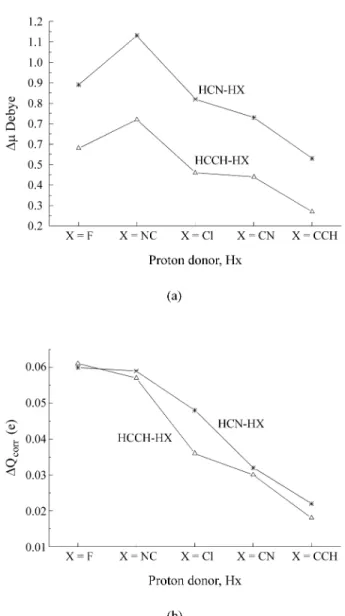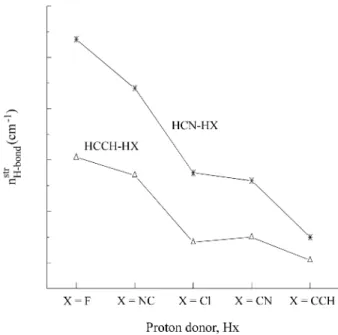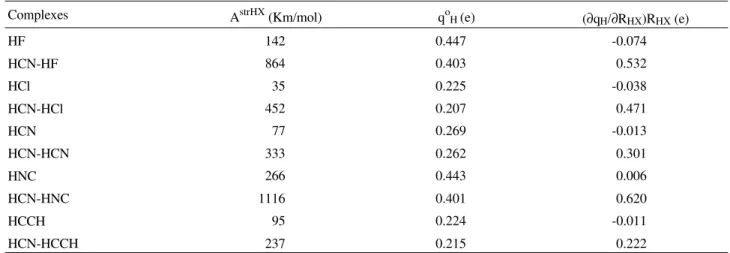An
Ab Initio
MP2 Study of HCN-HX Hydrogen Bonded Complexes
Regiane C.M.U. Araújoa, and Mozart N. Ramosb
a
Departamento de Química, Universidade Federal da Paraíba, 58036-300 João
Pessoa - PB, Brazil
b
Departamento de Química Fundamental, Universidade Federal de Pernambuco,
50739-901Recife - PE, Brazil
Received: February 5, 1997
Um estudo ab initio MP2/6-311++G** foi realizado para obter geometrias, energias de
establização e propriedades vibracionais dos complexos de hidrogênio HCN-HX com X = F, Cl, NC, CN e CCH. Os resultados obtidos revelaram que: (i) os valores calculados dos comprimentos das ligações de hidrogênio estão em excelente concordância com seus valores exeperimentais; (ii) a força da ligação-H está associada com a transferência de carga intermolecular e segue a ordem: HCN-HNC ≈ HCN-HF > HCN-HCl ≈ HCN-HCN > HCN-HCCH; (iii) correção BSSE introduz uma redução média de 2.4 kJ/mol na energia de estabilização MP2/6-311++G**; (iv) as energias do ponto-zero calculadas reduzem a estabilidade destes complexos e estão em boa concordância com os valores experimentais disponíveis; (v) a frequência de estiramento da molécula livre H-X sofre, como esperado, um deslocamento para baixo no espectro após a formação da ligação de hidrogênio e quanto mais curta a distância da ligação-H menor será este deslocamento; (vi) a intensidade no infravermelho deste estiramento H-X sofre a mudança mais pronunciada após a complexação, verificando-se um aumento substancial devido ao termo de fluxo de carga; (vii) as frequências de estiramento intermolecular destes complexos HCN-HX mostram uma concordância muito boa com os seus valores experimentais; e, finalmente, (viii) Os resultados obtidos para HCN-HX seguem o mesmo perfil daqueles observados para os complexos do tipo acetileno-HX. Entretanto, nestes últimos, as mudanças nas propriedades moleculares de suas moléculas livres, após a complexação, são menos pronunciadas do que aquelas observadas para os complexos HCN-HX.
An ab initio MP2/6-311++G** study has been performed to obtain geometries, binding energies
and vibrational properties of HCN-HX H-bonded complexes with X = F, Cl, NC, CN and CCH. These MP2/6-311++G** results have revealed that: (i) the calculated H-bond lengths are in very good agreement with the experimental ones; (ii) the H-bond strength is associated with the intermolecular charge transfer and follows the order: HNC ≈ HF > HCl ≈ HCN-HCN > HCN-HCN-HCCH; (iii) BSSE correction introduces an average reduction of 2.4 kJ/mol on the MP2/6-311++G** binding energies, i.e. 11% of the uncorrected binding energy; (iv) the calculated zero-point energies reduce the stability of these complexes and show a good agreement with the available experimental values; (v) the H-X stretching frequency is shifted downward upon H-bond formation. This displacement is associated with the H-bond length; (vi) The more pronounced effect on the infrared intensities occurs with the H-X stretching intensity. It is much enhanced after complexation due to the charge-flux term; (vii) the calculated intermolecular stretching frequencies are in very good agreement with the experimental ones; and, finally, (viii) the results obtained for the HCN-HX complexes follow the same profile as those found for the acetylene-HX series but, in the latter case, the effects on the properties of the free molecules due to complexation are less pronounced than those in HCN-HX.
Introduction
Recently, we have performed a systematic ab initio
study1,2 using different basis sets at the Hartree-Fock (HF)
and Möller-Plesset 2 (MP2) levels of theory3 in order to
arrive at a better understanding of the nature of hydrogen bonding in T-type molecular complexes involving acety-lene as proton acceptor and monoprotic linear acids as proton donors. That study revealed that larger charge-trans-fer values are associated with stronger hydrogen bonds and larger H-X stretching frequency downward displacements, in agreement with the experimental data for these com-plexes4.
In another work5, we analyzed, by means of principal
component6 and factorial design7 models, how ab initio
wave function modifications affect the H-bond energies of acetylene-HX complexes. We have also analyzed the HCN-HX linear complexes, which have been the target of many theoretical8 and experimental9 studies, and
con-cluded that at least MP2/6-311++G** calculations are needed to correctly predict the H-bond energies of the HCN-HX complexes with X = F, Cl and CN. Del Bene et al.8(a),8(b) have also shown that intermolecular distances and
vibrational shifts of H-bonded complexes are well des-cribed with the second-order many-body Möller-Plesset level of theory using a split-valence basis set with polari-zation and diffuse functions. Indeed, our calculations1,2
with the larger 6-311++G** basis set at the MP2 level have correctly predicted the binding energy, the H-bond distance and the shift of the H-X stretching frequency of the acety-lene-HX complexes with X =F, Cl, CN, NC, CCH. This level of calculation was found to be essential for an
ade-quate description of nonspherical atomic densities and polarizability effects10.
In this work, we present a comparative study of the molecular properties of both HCN-HX and HCCH-HX complexes in the series defined by X = F, Cl, CN, NC and CCH. Our interest is to analyse how the change of proton acceptor affects the structural, electronic, and vibrational properties of the monoprotic linear acids, as well as their binding energies. The 6-311++G** basis set at the MP2 level is used for all species. The calculations were per-formed on a VAX 6620 computer using the GAUSSIAN 92 program11.
Results and Discussion
Structural properties
The molecular geometries of the HCN-HX complexes and of the separated molecules were fully optimized at the MP2/6-311++G** level of calculation. The results are shown in Table 1. The following conclusions can be drawn: (i) The HC and HX bond lengths increase upon H-bond formation. The most significant change is found in the HX bond length which is directly involved in the H-bonding. The lengthening (δrHX) in the HCN-HX complex is larger
by approximately 0.004 Å than that found for the corre-sponding acetylene-HX T-complex. For instance, δrHF is
0.011 Å in HCN-HF whereas it is only 0.007 Å in acety-lene-HF. (ii) This lengthening is mainly due to charge transfer from the nitrogen lone-pair in HCN to the σ* antibonding orbital in HX, considering that the minimum energy electrostatic potential is along the molecular axis. (iii) The MP2/6-311++G** H-bond lengths (rN...H) are in
very good agreement with the corresponding experimental
Table 1. MP2/6-311++G** optimized structural parameters for the HCN-HX complexes with X = F, NC, Cl, CN and CCH. Experimental values in parentheses.
Structural
parame-ter(Å) HCN-HX complex
X = F X = NC X = Cl X = CN X = CCH
rHC 1.069 1.069 1.069 1.069 1.068
δrHC 0.001 0.001 0.001 0.001 0.000
rCN 1.168 1.169 1.170 1.170 1.171
δrCN -0.003 -0.003 -0.002 -0.001 -0.001
rHX 0.927 1.013 1.282 1.074 1.069
δrHX 0.011 0.012 0.008
(0.011)b 0.006 0.004
rNH 1.888 1.983 2.106 2.264 2.417
rN...X 2.815
(2.805)a
2.996 3.388
(3.405)b
3.338 (3.331)a
3.486 (3.480)a
values. For instance, the calculated value for rN...F in
HCN-HF is 2.815 Å, very close to the experimental value of 2.805 Å. The MP2/6-311++G** calculations have also yielded excellent results for the acetylene-HX T-com-plexes. (iv) The C≡N bond lengths in HCN decrease upon H-bond formation, in contrast to what is found for the HC and HX distances.
Electronic properties
Table 2 shows values of uncorrected (∆E) and corrected (∆E’) binding energies, binding energies corrected by zero-point energies (ZPE), dipole moments (µ), polarity en-hancements (∆µ) and intermolecular charge transfers (∆Qcorr) of the HCN-HX linear complexes. ∆E was
deter-mined by subracting the total energy of each hydrogen complex from the sum of the total energies of its isolated molecules. Since the binding energies include a basis set superposition error (BSSE)12 due to the supermolecule
approach, the full counterpoise method of Boys and Ber-nardi13 was employed to estimate the BSSE, resulting in the
corrected ∆E’ values. The polarity enhancement (∆µ) was calculated as the difference between the complex dipole moment and the sum of the dipoles of the isolated mole-cules. ∆Qcorr, which represents the amount of charge
trans-ferred from the proton acceptor (HCN) to the proton donor molecule after complexation, was calculated using the standard Mulliken atomic charges corrected by a specific overlap tensor element of the charge-charge flux-overlap (CCFO) model14 for infrared intensities.
From Table 2 we see that the ∆E values can be ordered
as HCN-HNC ≈ HCN-HF > HCN-HCl ≈
HCN-HCN > HCN-HCN-HCCH considering the accuracy for ∆E at
this level of calculation. The same order is verified for both the dipole enhancement and the intermolecular charge transfer. ∆E shows a good correlation with ∆Qcorr (R = 0.96
and n = 5), analogously to what was found for the acety-lene-HX series. It is interesting to note that ∆Qcorr values
are almost identical to those found for the acetylene-HX species (see Fig. 1). The ∆Qcorr values therefore do not
reflect the change from acetylene to hydrogen cyanide, despite the binding energies in HCN-HX being sistemati-cally larger than those in acetylene-HX. For a given HX proton donor, the binding energy is invariantly stronger in HCN-HX than in acetylene-HX by ≈ 40%. For instance, in HCN-HNC the value of ∆E is 30.9 kJ/mol as compared to 18.4 kJ/mol in acetylene-HNC.
The ∆µ dipole enhancement, in turn, correctly reflects the proton acceptor change. For proton donors, ∆E shows a good correlation with ∆µ (R = 0.94 and n = 10), which of course means that larger ∆E values are associated to larger
∆µ values.
The calculated ∆E values are in good agreement with the corresponding experimental binding energies. For in-stance, ∆E is 20.8 kJ/mol for HCN-HCl using the MP2/6-311++G** calculation, whereas experimental value is 23.0 kJ/mol9(j). For ease of comparison, we used
‘‘experi-mental electronic binding energies’’ derived from Del Bene
et al.8(b) using the experimental binding enthalpies. Thus,
the value of the equilibrium dissociation energy for HCN-HF is 28.77 kJ/mol using high resolution FTIR spectros-copy9(d), whereas its ‘‘modified’’ value is 29.7 kJ/mol. This
MP2/6-311++G** value is 30.4 kJ/mol.
The BSSE correction introduces an average reduction of 2.45 kJ/mol to the MP2/6-311++G** results (11% of the
Table 2. MP2/6-311++G** values of the uncorrected (∆E) and corrected (∆E’) binding energies, binding energies inclunding zero-point contributions (∆Ezpe), dipole moments (µ), polarity enhancements (∆µ) and intermolecular charge transfers (∆Qcorr) for HCN-HX complexes with X = F, NC, Cl, CN and CCH. Experimental values are given in parentheses.
Parameter Complex
HCN-HF HCN-HNC HCN-HCl HCN-HCN HCN-HCCH
∆E (kJ mol-1)
30.4 (29.7)a
30.9 20.8
(23.0) b
19.5 (18.8) c
10.9
∆E’ (kJ mol-1)
27.6 28.6 17.0 17.7 9.3
∆Ezpe (kJ mol-1)
22.5
(21.7)f 25.4 16.3 (15.9)15.8 e
8.2
µ (Debye) 5.86
(5.61) d
7.44 5.20 6.73 3.53
∆µ (Debye) 0.89
(0.80) d 1.13 0.82 0.73
0.53
∆Qcorr (e) 0.060 0.059 0.048 0.032 0.022
uncorrected ∆E). This value is much lower than that found for the acetylene-HX complexes (33%)2. It is also
interest-ing to note that the BSSE correction for HCN-HF obtained from Del Bene9(a) is 2.5 kJ/mol using a MP4/cc-pVTZ+
calculation, which is in excellent agreement with our value of 2.8 kJ/mol. Furthermore, the uncorrected ∆E values for HCN-HF using both the MP4/cc-pVTZ+ and MP2/6-311++G** calculations are also in very good agreement,
i.e., 31.3 kJ/mol and 30.4 kJ/mol, respectively. The BSSE
corrections do not alter the order of the values of the binding energies: HCN-HNC ≈ HCN-HF > HCN-HCl ≈
HCN-HCN > HCN-HCCH.
Since zero-point vibrational energy contributions have a non negligible effect on the stabilities of hydrogen-bonded complexes, we have evaluated these contributions using the MP2/6-311++G** level of theory for the
HCN-HX complexes. The zero-point contributions given in Ta-ble 2 vary from 7.9 kJ/mol for HCN-HF to 2.7 kJ/mol for HCN-HCCH. The initial order of the binding energies of the HCN-HX complexes are not altered by correction of the zero-point vibrational energies. The MP2/6-311++G** corrected values (∆Ezpe) are in very good agreement with
the corresponding available experimental values. For in-stance, the calculated value for ∆Ezpe in HCN-HF is
22.5 kJ/mol, very close to the experimental value of 21.7 kJ/mol.
Vibrational properties
HX stretching frequencies and infrared intensities
The calculated harmonic frequencies of the HX mole-cules are overestimated by 5-7% with respect to the experi-mental frequency values, whereas the calculated infrared intensities are 20 to 30% larger than the experimental values, except for HCl, when the overestimation is only by 9%. These differences are due to lack of anharmonicity correction, basis set truncation, and incomplete treatment of electron correlation.
Upon H-bond formation the HX stretching frequency is shifted downward. For instance, the calculated displace-ment is 242 cm-1 for HF after complexation, in excellent
agreement with the experimental value of 245 cm-1. Larger
shifts are associated with stronger H-bond strengths, analo-gously to what was found for the acetylene-HX complexes. This implies that, since the H-bonds are stronger in the
HCN complexes, the ∆νHX shifts in HCN-HX must be
larger than the corresponding shifts in the acetylene-HX series. In Table 3 values of ∆νHX for acetylene-HX are given in brackets. For HCN-HF, for instance, ∆νHX is -242 cm-1, whereas it is only -157 cm-1 in acetylene-HF.
Therefore, the weakness of the HF bond after complexation in HCN-HF is larger by about 100 cm-1 than what was
found in acetylene-HF.
Del Bene et al.8(a) have also obtained similar results for
the HCN-HX and CH3CN-HX complexes, with X = F or
Cl, using MP2 and B3LYP calculations with a 6-31+G(d,p) basis set. The CH3CN-HX complexes are more strongly
bound than the HCN-HX ones since the substitution of methyl for hydrogen in HCN increases both the electron density on the nitrogen and the polarizability of the proton-acceptor molecule. Therefore, their HX stretching fre-quency shifts are larger than those in the HCN-HX species. As can be seen from Table 3, the HX stretching inten-sities of the proton donor molecule are much enhanced upon H-bond formation. The calculated ratio, AHXC/AHXis,
varies from 12.5 in HCN-HCl to 2.5 in HCN-HCCH. It is now well established that this increase is due to the charge-flux term1,2, which is strongly affected by complexation, in
contrast to what happens with the hydrogen charge. The latter is always positive, whereas the charge-flux is slightly
negative in the free molecule and becomes quite positive after complexation. In the complex, the hydrogen charge and the charge-flux have the same algebraic sign, then, since the HX stretching intensity is proportional to the square sum of these terms, it is enormously increased upon complexation. Table 4 shows the MP2/6-311++G** values of HX stretching intensities, hydrogen corrected charges and charge-fluxes of HX before and after complexation. For instance, the charge-flux term goes from -0.074e in the free HF molecule to 0.532e after complexation, whereas qo
H remains around 0.4e. The more pronounced effect on
the HX stretching is found for chlorine, where the ratio is 12.5. The intensity ratios in the series are in the order Cl > F > NC > CN > CCH, analogously to what was found for the acetylene-HX complexes2.
Other vibrational modes
The C≡N stretching of the HCN proton acceptor mole-cule is little affected by complexation, the C≡N frequency being only slightly shifted upward. The most pronounced effect is found for fluorine, that exhibits a displacement of 31 cm-1, which is in very good agreement with the
experi-mental value of 24 cm-1, while the smaller, 7 cm-1 occurs
when X = CCH. The C≡N stretching intensity either before and after complexation is very weak, about 1 Km/mol.
The doubly degenerate bending frequencies of HX with X = CN, NC and CCH are shifted upward upon H-bond formation, as in the acetylene-HX complexes. The shifts are 257 cm-1 for X = NC, 101 cm-1 for X = CN and 45 cm-1
for X = CCH, respectively, corresponding to bending fre-quencies in the free molecule of 506 cm-1, 729 cm-1 and
765 cm-1, respectively. The bending intensities are slightly
increased by ≈ 1.2 after complexation. For instance, the bending intensity of HNC goes from 157 Km/mol in the free molecule to 188 Km/mol upon H-bond formation.
It is interesting to note that the bending intensities can be estimated from hydrogen corrected charge in HX by means of the following equation15:
AHX bend ≅ K (q 0 H)
2 (1)
where K = 975 for intensity values in Km/mol. It is important to point out that the charge-flux term is zero for bending modes in linear molecules16,17. Thus, for instance,
using the value given in Table 4 for the hydrogen charge in
acetylene in the HCN-HCCH complex, qo
H = 0.22e, one
obtain a predicted intensity of 47 Km/mol, in good agreement with the MP2/6-311++G** calculated values,
i.e., 52 Km/mol.
Figure 2. The MP2/6-311++G** intermolecular stretching frequencies for HCN-HX and acetylene-HX with X = F, NC, Cl, CN and CCH.
Table 3. MP2/6-311++G** values of the harmonic frequencies, frequency shifts, infrared intensities and intensity ratios after complexation of the HX stretching. Experimental values are given in parentheses, whereas the corresponding MP2/6-311++G** values for acetylene-HX are given in brackets.
Mode HCN-HX νHxis (cm-1) (νHXC - νHXis) (cm-1) AHXis (Km/mol) AHXC/AHXis
HX stretch X = F 4199
(3961) d
-242 [-157] (-245)a
142 (77) e
6.1 [4.2]
X = NC 3838 -218 [-139] 266 4.2 [3.1]
X = Cl 3085
(2888) g -111 [ -69] (-79) b (32)35 e 12.5 [7.2]
X = CN 3484
(3311) d
-76 [-43] (-70) c
77 (59) e
4.3 [2.9]
X = CCH 3458
(3282) f -27 [-13] (70)95 f 2.5 [1.9]
New vibrational modes
The formation of HCN-HX complexes gives rise to new vibrational modes, which are given in Table 5. The values of the harmonic frequencies and IR intensities of these new modes exhibit several features: (i) The MP2/6-311++G** intermolecular stretching frequencies (stretch-H or νHb ) are in very good agreement with the available experimental values, analogously to what was found for the acetylene-HX complexes. In the latter case, the values of the intermo-lecular stretching frequencies are lower than the corresponding values in HCN-HX (see Fig. 2), in agree-ment with their binding energies. Experiagree-mental values also confirm the larger intermolecular stretching frequencies in HCN-HX relative to the corresponding values in acetylene-HX. For instance, the H-stretch experimental value in HCN-HCN is 119 cm-1, whereas the corresponding value
in acetylene-HX is only 82 cm-1. Values of νHb in both the
HCN-HX and acetylene-HX complexes follow the order F > NC > Cl ≈ CN > CCH, in agreement with the corre-sponding H-bond lengths. On the other hand, their intensi-ties are very weak. (ii) The new bending frequencies of HX arising after complexation are larger than those in the HCN proton acceptor molecule. Furthermore, the IR bending
intensities of HX are more intense than those of HCN, except for X = CCH. For instance, the HX bending intensity is 45 Km/mol in HCN-HCN whereas its value in the HCN proton acceptor molecule is only 7 Km/mol. The corre-sponding frequencies are 137 cm-1 and 47 cm-1,
respec-tively. (iii) Finally, it is interesting to point out that the new bending mode of HX for X = F or Cl, which corresponds to a pure rotation in the free HX molecule, becomes infra-red-active after complexation. Besides, it has a fairly large intensity, especially in HF (177 Km/mol), determined for the most part by the hydrogen corrected charge. For in-stance, the calculated intensity in HCN-HCl is 56 Km/mol, whereas the value estimated by Eq. 1 is 42 Km/mol.
Conclusions
Our MP2/6-311++G** calculations show that the struc-tural, electrical and vibrational changes that take place in the free HCN and HX molecules after complexation follow the same behaviour as those found in the acetylene-HX complexes. In the latter ones, however, the effects are less pronounced than in HCN-HX, which are more strongly bound. The binding energies in these complexes show a good linear correlation with their dipole enhancements.
Table 4. MP2/6-311++G** values of H-X stretching intensities and their intensity parameters before and after complexation.
Complexes AstrHX (Km/mol) qo
H (e) (∂qH/∂RHX)RHX (e)
HF 142 0.447 -0.074
HCN-HF 864 0.403 0.532
HCl 35 0.225 -0.038
HCN-HCl 452 0.207 0.471
HCN 77 0.269 -0.013
HCN-HCN 333 0.262 0.301
HNC 266 0.443 0.006
HCN-HNC 1116 0.401 0.620
HCCH 95 0.224 -0.011
HCN-HCCH 237 0.215 0.222
Table 5. Harmonic frequencies and IR intensities of the new low-frequency vibrational modes. Experimental data in parentheses.
Complex Vibrational properties New vibrational modes
stretch-H bend(HCN) bend(HX)
HCN-HF νi (cm-1) Ai (Km/mol) 167 (168) a 4 80 11 598 177
HCN-HNC νi (cm-1) Ai (Km/mol) 148 5 63 5 159 28
HCN-HCl νi (cm-1) Ai (Km/mol) 115 (111) b 3 53 15 311 56
HCN-HCN νi (cm-1) Ai (Km/mol) 112 (119) c 1 47 7 137 45
HCN-HCCH νi (cm-1) Ai (Km/mol) 90 1 27 27 106 3
The intramolecular vibrational modes exhibit the usual effects of H-bonding formation, which are: (i) The HX stretching frequency is shifted downward whereas its IR intensity is much enhanced after complexation due to the charge-flux, (ii) The HCN proton acceptor spectrum is little affected by complexation and (iii) The new vibrational modes show several interesting features, especially the intermolecular stretching frequency and the bend modes of HF and HCl in HCN-HX, which are pure rotations in the free molecule.
Acknowledgments
The authors gratefully acknowledge partial financial support from the Brazilian funding agencies CNPq, CAPES-PADCT and FINEP. We would also like to thank the referees of this work for their recommendations.
References
1. Araújo, R.C.M.U.; Silva, J.B.P. da; Ramos, M.N.
Spectrochim. Acta1995, 51A, 821.
2. Araújo, R.C.M.U.; Ramos, M.N. J. Mol. Struct. (THEOCHEM)1996, 366, 233.
3. (a) Pople, J.A.; Binkley, J.S.; Seeger, R. Int.J. Quan-tum Chem.: QuanQuan-tum Chem. Symp. 1976, 10, 1; (b)
Krishman, R.; Pople, J.A. Int. J. Quantum Chem. 1978, 14, 91; (c) Barlett, R.J.; Silver, D.M. J. Chem. Phys. 1975, 62, 3258.
4. Mc Donald, S.A.; Johnson, G.L.; Keelan, B.W.; An-drews, L. J. Am. Chem Soc. 1980, 102, 2892.
5. Araújo, R.C.M.U.; Silva, J.B.P. da; Neto, B.B.;
Ra-mos, M.N.; Bruns, Roy E. J. Chem. Soc. Faraday
Trans. II to be submitted.
6. Mardia, K.V.; Kent, J.T.; Bibby, J.M. Multivariate Analysis, Academic Press, London, 1979.
7. Box, G.E.P.; Hunter, W.G.; Hunter, J.S. Statistics for Experiments, Wiley, New York, 1978.
8. (a) Del Bene, J.E. Int. J. Quantum Chem.: Quantum Chem.Symp. 1992, 26, 527; (b) Del Bene, J.E.; Person,
W.B.; Szczepaniak, K. J. Phys. Chem. 1995, 99,
10705; (c) Tostes, J.G.R.; Taft, C.A.; Ramos, M.N. J. Phys. Chem. 1987, 91, 3157; (d) Curtiss, L.A.; Pople,
J.A. J. Mol. Spectrosc. 1973, 48, 413.
9.(a) Legon, A.C.; Millen, D.J.; Rogers, S.C. Proc. R. Soc. Lond. 1980, A370, 213; (b) Wofford, B.A.;
Bevan, J.W.; Olson, W.B.; Lafferty, W.J. Chem. Phys. Lett. 1986, 124, 579; (c) Wofford, B.A.; Lieb, S.G.;
Bevan, J.W. J. Chem. Phys. 1987, 87, 4478; (d)
Wof-ford, B.A.; Eliades, M.E.; Lieb, S.G.; Bevan, J.W. J. Chem. Phys. 1987, 87, 5674; (e) Legon, A.C.;
Camp-bell, E.J.; Flygare, W.H. J. Chem. Phys. 1982, 76,
2267; (f) Legon, A.C.; Millen, D.J. Proc. R. Soc. Lond. 1988, A417, 21; (g) Wofford, B.A.; Bevan, J.W.;
Olson, W.B.; Lafferty, W.J. J. Chem. Phys. 1986, 85,
105; (h) Howard, N.W.; Legon, A.C. J. Chem. Phys. 1986, 85, 6898; (i) Legon, A.C.; Millen, D.J. Chem. Rev. 1986, 86, 635; (j) Mettee, H.D. private
commu-nication; (k) Barnes, A.J. J. Mol. Struct. 1983, 100,
259; (l) Millen, D.J. J. Mol. Struct. 1978, 45, 1; (m)
Bishop, D.M.; Cheung, L.M. J. Phys. Chem. Ref. Data 1982, 11, 119; (n) Craw, J.S.; Nascimento, M.A.C.;
Ramos, M.N. Spectrochim. Acta 1991, 47A, 69; (o)
Mettee, H.D. J.Phys.Chem. 1973, 77, 1762; (p)
Bux-ton, L.W.; Campbell, E.J.; Flygare, W.H. Chem, Phys. Lett. 1981, 56, 399; (q) Suzuki, I.; Pariseau, M.ª;
Overend, J. J. Chem. Phys.1966, 44, 3561; (r) Nesbitt,
D.J. Chem. Rev. 1988, 88, 843.
10. Buckingham, A.D.; Fowler, P.W.; Huston, J.M.
Chem. Rev. 1988, 88, 963.
11. GAUSSIAN 92, Revision E.1, Frisch, M.J.; Trucks, G.W.; Head-Gordon, M.; Gill, P.M.W.; Wong, M.W.; Foresman, J.B.; Johnson, B.G.; Schelegel, H.B.; Robb, M.A.; Pepogle, E.S.; Gomperts, R.; Andres, J.L.; Raghavachari, K.; Binkley, J.S.; Gonzales, C.; Martin, R.L.; Fox, D.J.; Defrees, D.J.; Baker, J.; Ste-wart, J.J.P.; Pople, J.A. GAUSSIAN, INC., Pittsburgh PA, (1992).
12. Kestner, N.R. J. Chem. Phys. 1968, 48, 252.
13. Boys, S.F.; Bernardi, F. Mol. Phys. 1970, 19, 553.
14. King, W.T.; Mast, G.B. J. Phys. Chem. 1976, 80,
2521.
15. Gussoni, M. J. Mol. Struct. 1984, 113, 323.
16. Dinur, U. Chem. Phys. Lett. 1990, 166, 211.
17. Gussoni, M.; Ramos, M.N.; Castiglioni, C.; Zerbi, G.
